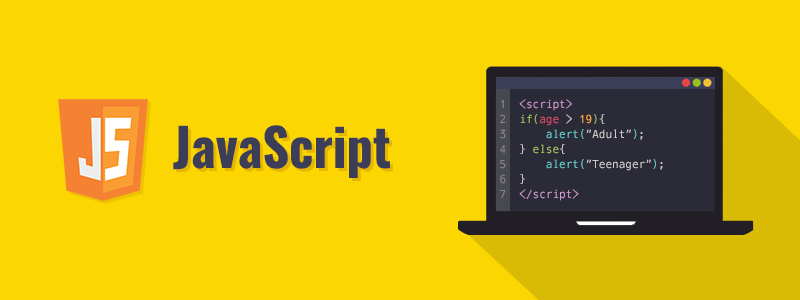What is JavaScript?
- A language for the web browser and the server (node.js)
- High level (very abstracted), interpretted programming language (not pre-compiled, more or less true)
- Implements the ECMAScript® Language Specification
- Is multi-paradigm (you can write your code in many different ways)
Why learn JavaScript?
- You can build lots of things with it!
- Iteractive user interfaces using awesome frameworks
- Very fast server side applications
- Mobile apps
- Even desktop applications
What will we learn?
- This is a crash course.
- Just the basics, no frameworks (yet)
variablesanddata typesconditionalsarraysobjectsloopsfunctions- Keep on learning!
- mdn
- codecademy
- udemy
- many more
How do we use JavaScript?
index.html
<!DOCTYPE html>
<html lang="en">
<head>
<title>How do we use JavaScript?</title>
<link rel="stylesheet" href="style.css">
</head>
<body>
<!--we want our HTML and CSS to load first-->
<script src="script.js"></script>
</body>
</html>script.js
console.log('hello world!');Variables
let age = 30; // can be reassigned
age = 31; // yes
const name = 'Radu'; // can NOT be reassigned
name = 'Tudor'; // nope TypeError: Assignment to constant variable.
const name; // MUST be initializedSyntaxError: Missing initializer in const declaration.
Always use
constunless you're sure you want to reassign that value.
Data types
numbers
10
-50
3.14159strings
'hello world'
"double quotes are also cool"booleans
true
falseundefinedandnull
undefined
nullobject
{
name: 'Claudia',
age: 29
isLoggedIn: true
}
// arrays are also objects
typeof [1, 2, 3] // object
typeof null // object 🤦
/*
Because the spec says so.
This is generally regarded as a mistake.
*/autoboxing
const name = 'Radu';
typeof name; // string
name.length; // 4This a process called autoboxing. When you call a property on a primitive types, JavaScript will first convert it into a temporary wrapper object, and access the property / method on it, without affecting the original.
String concatenation
normal addition
const name = 'Radu';
const age = 30;
const message = 'My name is ' + name + ' and I am ' + age;
// My name is Radu and I am 30;template strings
const name = 'Radu';
const age = 30;
const message = `My name is ${name} and I am ${age}`;
// My name is Radu and I am 30;
// We MUST use backticks!Conditionals
if
const myAge = 30;
const yourAge = 30;
if (myAge > yourAge) {
console.log('I am older than you.');
}else
const myAge = 30;
const yourAge = 30;
if (myAge > yourAge) {
console.log('I am older than you.');
}
else {
console.log('I am younger than you.');
}else if
const myAge = 30;
const yourAge = 25;
if (myAge > yourAge) {
console.log('I am older than you.');
}
else if (myAge === yourAge) {
console.log('We are the same age.');
}
else {
console.log('I am younger than you.');
}Checking for equality
==
- Will compare for equality after doing any necessary type conversions
const myAge = 30;
const yourAge = '30'
myAge == yourAge; // true===
- Will not do the conversion
const myAge = 30;
const yourAge = '30'
myAge === yourAge; // falseThere are many things to say here but most importantly, always use
===.
Arrays
- Lists that hold multiple values
- Are homogeneous (can store mixed data types)
- We can access individual elements or add new ones.
const names = ['Silvia', 'Victor', 'Robert'];
const values = ['test', 10, true, null, [1, 2]];declaration
Remember that arrays are zero based. The first element has index
0.
const name = names[0]; // Silvia index
const name = names[0]; // Silvia length
console.log(names.length); // 3.push()
names.push('Radu');
console.log(names); // 'Silvia', 'Victor', 'Robert', 'Radu'
console.log(names.length); // 4There are more array methods, read about them here.
While an array is of type
object, you can check if a value is an array usingArray.isArray().
The for loop
- Loops offer a quick and easy way to do something repeatedly.
- There are many different kinds of loops, but they all essentially do the same thing.
- They repeat an action some number of times.
structure
for ([initialExpression]; [condition]; [incrementExpression])
statementimplementation
for (let i = 0; i < 3; i++) {
console.log(i)
}
// 0
// 1
// 2arrays
const names = ['Silvia', 'Victor', 'Robert'];
for (let i = 0; i < names.length; i++) {
console.log(names[i])
}
// 'Silvia'
// 'Victor'
// 'Robert'Always be careful to not write an infinite loop.
for (let i = 0; i < 3; i--) {
console.log(names[i])
}
// 0
// -1
// -2
// Infinity...Object literals
- a collection of related data
- key : value pairs
- used when storing information
- makes stuff easier to read
- useful sending / receiving a request to / from the server
declaring properties
const person = {
name: 'Silvia',
age: 21,
isLoggedIn: true
};
person.name; // Silvia
person.age; // 21reading properties
person.name; // Silvia
person.age; // 21
person.height; // undefinedwriting properties
person.address = 'Park Street no. 11';Functions
- One of the fundamental building blocks in JavaScript
- A function is a JavaScript procedure—a set of statements that performs a task or calculates a value.
- To use a function, you must define it somewhere in the scope from which you wish to call it.
declaration
- name
- list of parameters (optional)
- statements enclosed in curly brackets
{}
function sayHello() {
console.log('hello world');
}invocation
sayHello();
// hello worldone parameter
function square(number) {
return number * number;
}
const number = square(4); // 16multiple parameters
function add(a, b) {
return a + b;
}
const sum = add(100, 300); // 400
